Detailed Critique: Evaluating Research Paper - Strengths & Weaknesses
VerifiedAdded on 2023/06/12
|5
|1050
|73
Essay
AI Summary
This essay presents a comprehensive critique of a provided research paper, meticulously examining its strengths and weaknesses across various dimensions. The critique identifies the use of a pilot study and ethical considerations as strengths, while pointing out weaknesses related to clearance processes, potential bias in participant selection, lack of author details, and the use of colloquial language. Specific suggestions for improvement are offered, focusing on refining language, providing necessary author information, and enhancing the rigor of the research methodology. The analysis underscores the importance of addressing these weaknesses to enhance the research's applicability and credibility in the field of international business. Desklib offers a wealth of similar solved assignments and past papers to aid students in their academic pursuits.
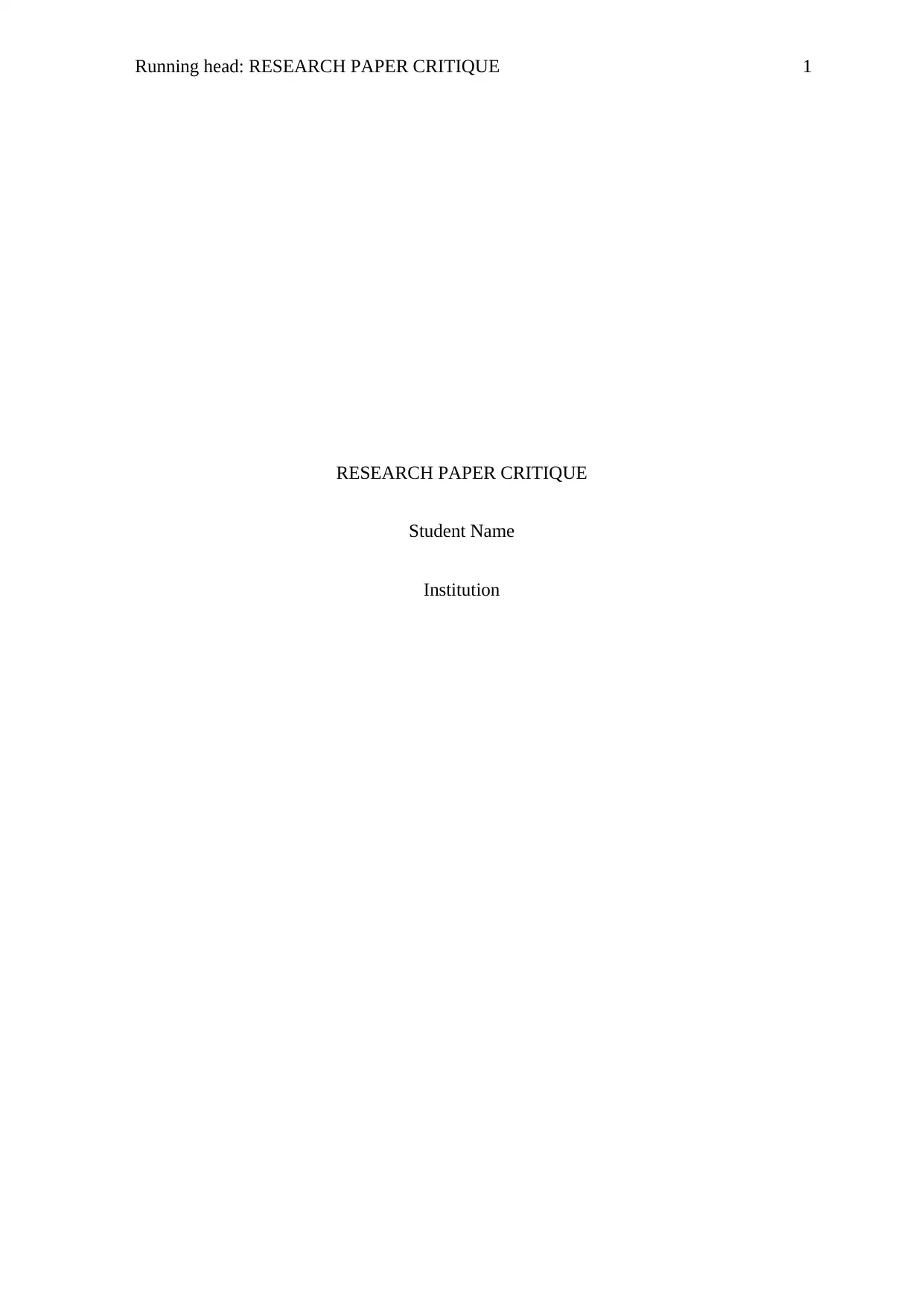
Running head: RESEARCH PAPER CRITIQUE 1
RESEARCH PAPER CRITIQUE
Student Name
Institution
RESEARCH PAPER CRITIQUE
Student Name
Institution
Paraphrase This Document
Need a fresh take? Get an instant paraphrase of this document with our AI Paraphraser
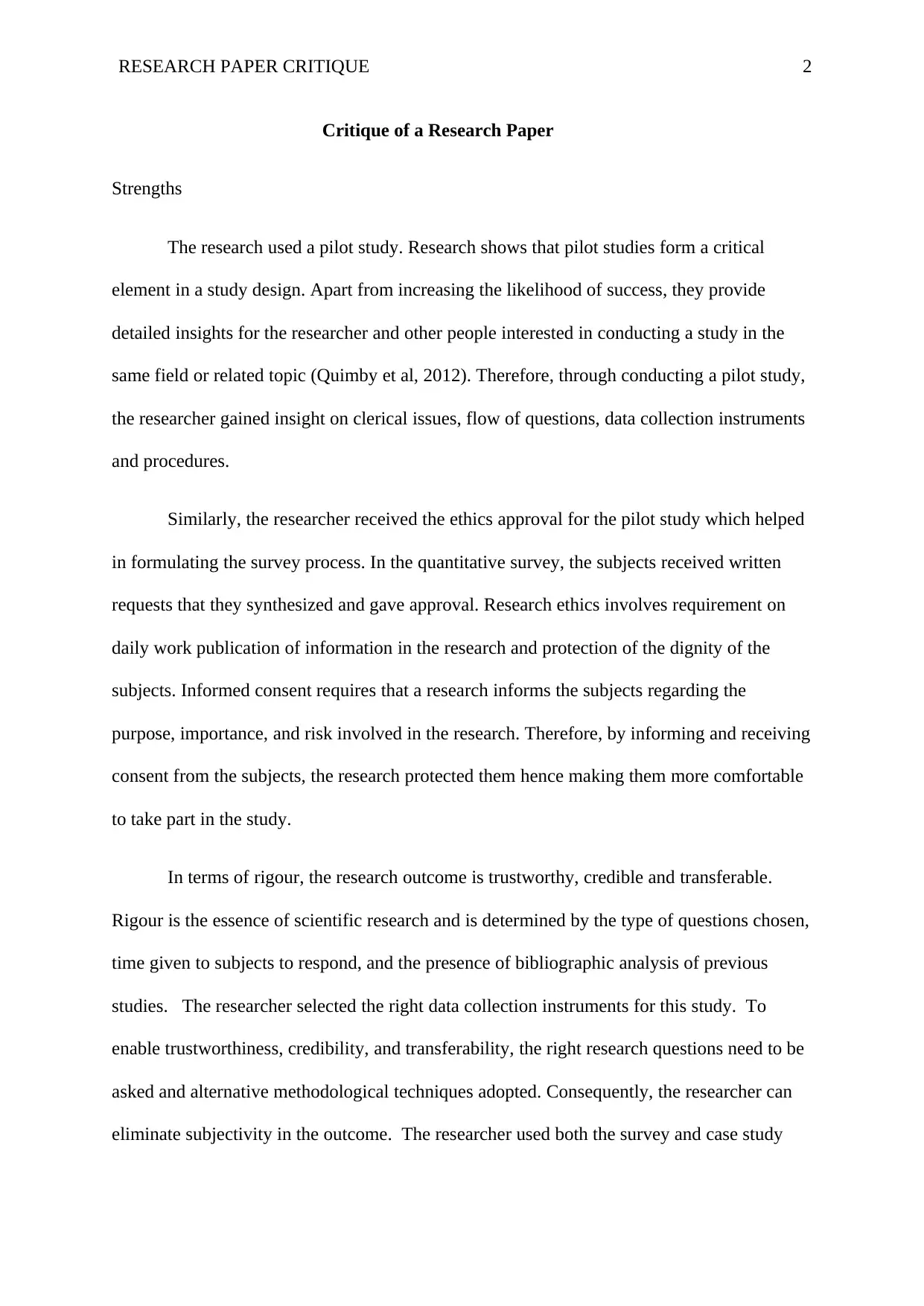
RESEARCH PAPER CRITIQUE 2
Critique of a Research Paper
Strengths
The research used a pilot study. Research shows that pilot studies form a critical
element in a study design. Apart from increasing the likelihood of success, they provide
detailed insights for the researcher and other people interested in conducting a study in the
same field or related topic (Quimby et al, 2012). Therefore, through conducting a pilot study,
the researcher gained insight on clerical issues, flow of questions, data collection instruments
and procedures.
Similarly, the researcher received the ethics approval for the pilot study which helped
in formulating the survey process. In the quantitative survey, the subjects received written
requests that they synthesized and gave approval. Research ethics involves requirement on
daily work publication of information in the research and protection of the dignity of the
subjects. Informed consent requires that a research informs the subjects regarding the
purpose, importance, and risk involved in the research. Therefore, by informing and receiving
consent from the subjects, the research protected them hence making them more comfortable
to take part in the study.
In terms of rigour, the research outcome is trustworthy, credible and transferable.
Rigour is the essence of scientific research and is determined by the type of questions chosen,
time given to subjects to respond, and the presence of bibliographic analysis of previous
studies. The researcher selected the right data collection instruments for this study. To
enable trustworthiness, credibility, and transferability, the right research questions need to be
asked and alternative methodological techniques adopted. Consequently, the researcher can
eliminate subjectivity in the outcome. The researcher used both the survey and case study
Critique of a Research Paper
Strengths
The research used a pilot study. Research shows that pilot studies form a critical
element in a study design. Apart from increasing the likelihood of success, they provide
detailed insights for the researcher and other people interested in conducting a study in the
same field or related topic (Quimby et al, 2012). Therefore, through conducting a pilot study,
the researcher gained insight on clerical issues, flow of questions, data collection instruments
and procedures.
Similarly, the researcher received the ethics approval for the pilot study which helped
in formulating the survey process. In the quantitative survey, the subjects received written
requests that they synthesized and gave approval. Research ethics involves requirement on
daily work publication of information in the research and protection of the dignity of the
subjects. Informed consent requires that a research informs the subjects regarding the
purpose, importance, and risk involved in the research. Therefore, by informing and receiving
consent from the subjects, the research protected them hence making them more comfortable
to take part in the study.
In terms of rigour, the research outcome is trustworthy, credible and transferable.
Rigour is the essence of scientific research and is determined by the type of questions chosen,
time given to subjects to respond, and the presence of bibliographic analysis of previous
studies. The researcher selected the right data collection instruments for this study. To
enable trustworthiness, credibility, and transferability, the right research questions need to be
asked and alternative methodological techniques adopted. Consequently, the researcher can
eliminate subjectivity in the outcome. The researcher used both the survey and case study
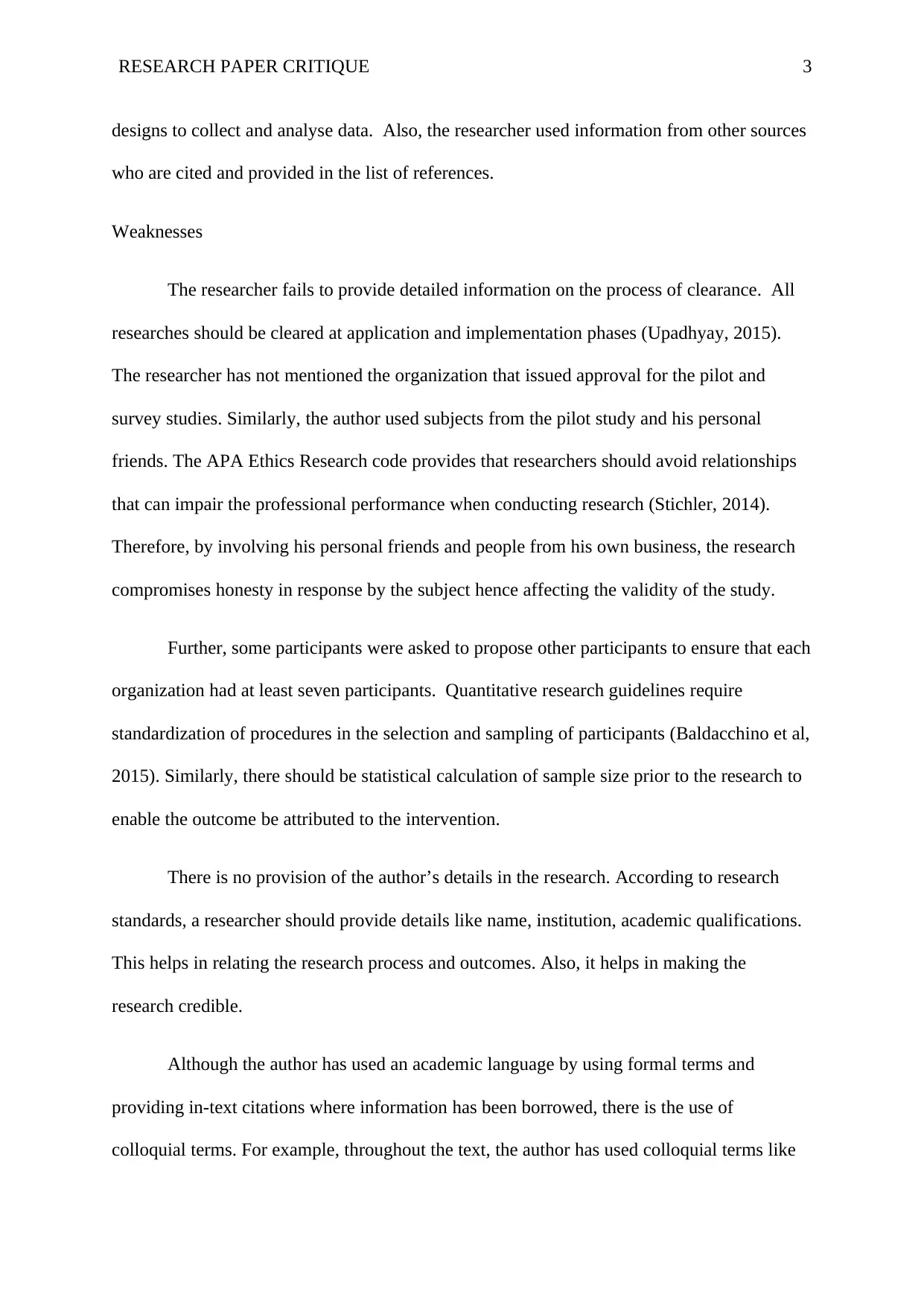
RESEARCH PAPER CRITIQUE 3
designs to collect and analyse data. Also, the researcher used information from other sources
who are cited and provided in the list of references.
Weaknesses
The researcher fails to provide detailed information on the process of clearance. All
researches should be cleared at application and implementation phases (Upadhyay, 2015).
The researcher has not mentioned the organization that issued approval for the pilot and
survey studies. Similarly, the author used subjects from the pilot study and his personal
friends. The APA Ethics Research code provides that researchers should avoid relationships
that can impair the professional performance when conducting research (Stichler, 2014).
Therefore, by involving his personal friends and people from his own business, the research
compromises honesty in response by the subject hence affecting the validity of the study.
Further, some participants were asked to propose other participants to ensure that each
organization had at least seven participants. Quantitative research guidelines require
standardization of procedures in the selection and sampling of participants (Baldacchino et al,
2015). Similarly, there should be statistical calculation of sample size prior to the research to
enable the outcome be attributed to the intervention.
There is no provision of the author’s details in the research. According to research
standards, a researcher should provide details like name, institution, academic qualifications.
This helps in relating the research process and outcomes. Also, it helps in making the
research credible.
Although the author has used an academic language by using formal terms and
providing in-text citations where information has been borrowed, there is the use of
colloquial terms. For example, throughout the text, the author has used colloquial terms like
designs to collect and analyse data. Also, the researcher used information from other sources
who are cited and provided in the list of references.
Weaknesses
The researcher fails to provide detailed information on the process of clearance. All
researches should be cleared at application and implementation phases (Upadhyay, 2015).
The researcher has not mentioned the organization that issued approval for the pilot and
survey studies. Similarly, the author used subjects from the pilot study and his personal
friends. The APA Ethics Research code provides that researchers should avoid relationships
that can impair the professional performance when conducting research (Stichler, 2014).
Therefore, by involving his personal friends and people from his own business, the research
compromises honesty in response by the subject hence affecting the validity of the study.
Further, some participants were asked to propose other participants to ensure that each
organization had at least seven participants. Quantitative research guidelines require
standardization of procedures in the selection and sampling of participants (Baldacchino et al,
2015). Similarly, there should be statistical calculation of sample size prior to the research to
enable the outcome be attributed to the intervention.
There is no provision of the author’s details in the research. According to research
standards, a researcher should provide details like name, institution, academic qualifications.
This helps in relating the research process and outcomes. Also, it helps in making the
research credible.
Although the author has used an academic language by using formal terms and
providing in-text citations where information has been borrowed, there is the use of
colloquial terms. For example, throughout the text, the author has used colloquial terms like
⊘ This is a preview!⊘
Do you want full access?
Subscribe today to unlock all pages.

Trusted by 1+ million students worldwide
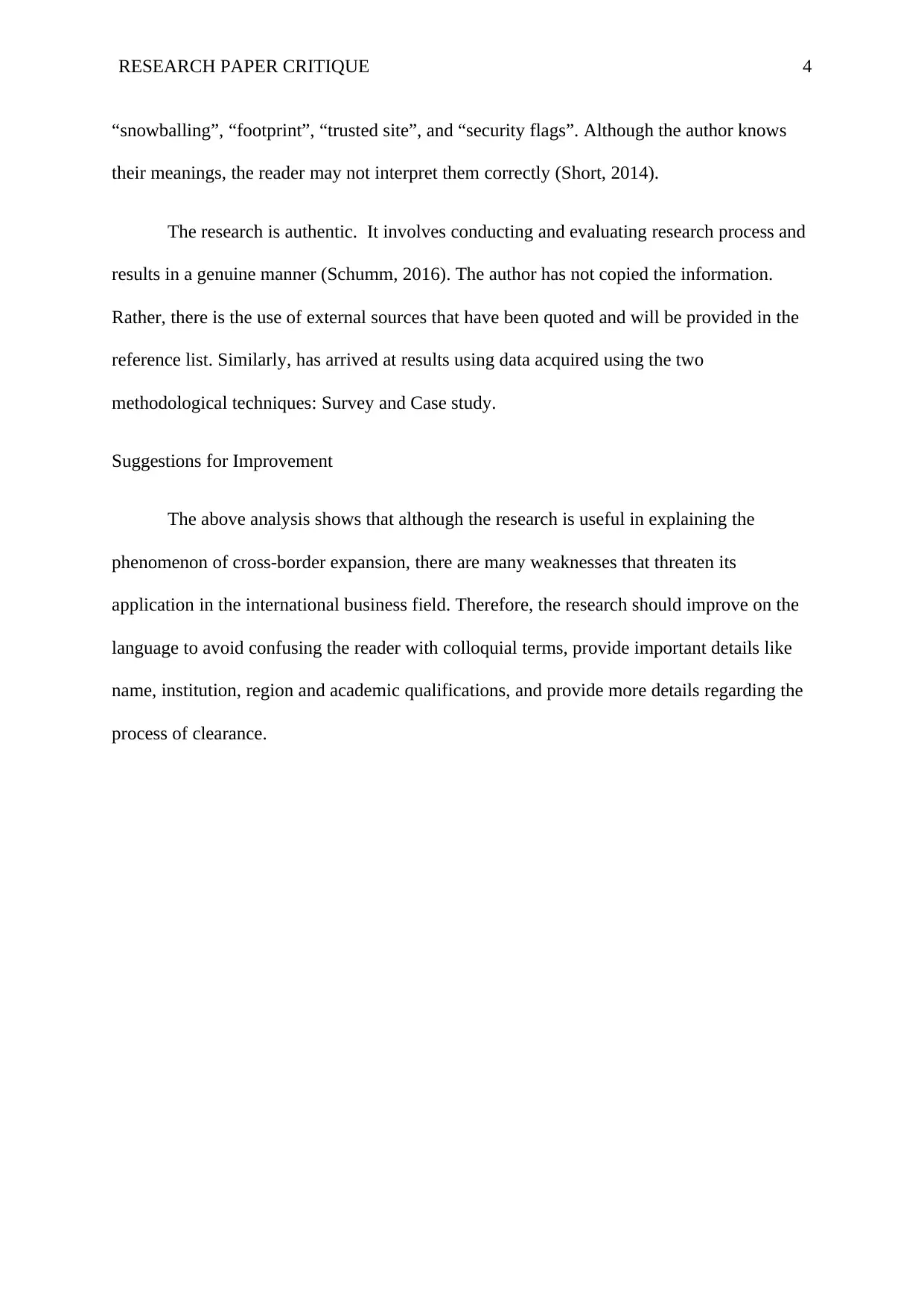
RESEARCH PAPER CRITIQUE 4
“snowballing”, “footprint”, “trusted site”, and “security flags”. Although the author knows
their meanings, the reader may not interpret them correctly (Short, 2014).
The research is authentic. It involves conducting and evaluating research process and
results in a genuine manner (Schumm, 2016). The author has not copied the information.
Rather, there is the use of external sources that have been quoted and will be provided in the
reference list. Similarly, has arrived at results using data acquired using the two
methodological techniques: Survey and Case study.
Suggestions for Improvement
The above analysis shows that although the research is useful in explaining the
phenomenon of cross-border expansion, there are many weaknesses that threaten its
application in the international business field. Therefore, the research should improve on the
language to avoid confusing the reader with colloquial terms, provide important details like
name, institution, region and academic qualifications, and provide more details regarding the
process of clearance.
“snowballing”, “footprint”, “trusted site”, and “security flags”. Although the author knows
their meanings, the reader may not interpret them correctly (Short, 2014).
The research is authentic. It involves conducting and evaluating research process and
results in a genuine manner (Schumm, 2016). The author has not copied the information.
Rather, there is the use of external sources that have been quoted and will be provided in the
reference list. Similarly, has arrived at results using data acquired using the two
methodological techniques: Survey and Case study.
Suggestions for Improvement
The above analysis shows that although the research is useful in explaining the
phenomenon of cross-border expansion, there are many weaknesses that threaten its
application in the international business field. Therefore, the research should improve on the
language to avoid confusing the reader with colloquial terms, provide important details like
name, institution, region and academic qualifications, and provide more details regarding the
process of clearance.
Paraphrase This Document
Need a fresh take? Get an instant paraphrase of this document with our AI Paraphraser
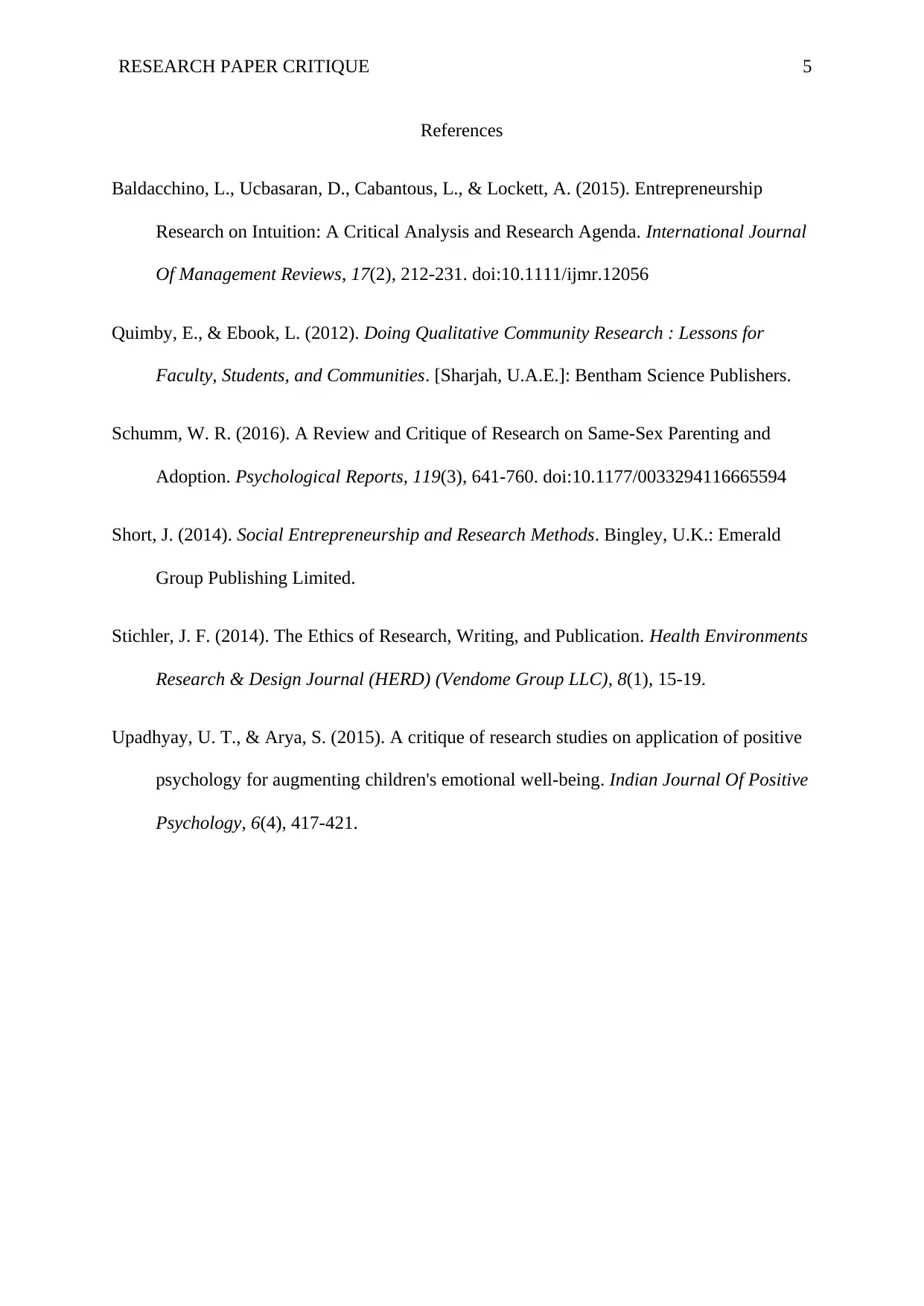
RESEARCH PAPER CRITIQUE 5
References
Baldacchino, L., Ucbasaran, D., Cabantous, L., & Lockett, A. (2015). Entrepreneurship
Research on Intuition: A Critical Analysis and Research Agenda. International Journal
Of Management Reviews, 17(2), 212-231. doi:10.1111/ijmr.12056
Quimby, E., & Ebook, L. (2012). Doing Qualitative Community Research : Lessons for
Faculty, Students, and Communities. [Sharjah, U.A.E.]: Bentham Science Publishers.
Schumm, W. R. (2016). A Review and Critique of Research on Same-Sex Parenting and
Adoption. Psychological Reports, 119(3), 641-760. doi:10.1177/0033294116665594
Short, J. (2014). Social Entrepreneurship and Research Methods. Bingley, U.K.: Emerald
Group Publishing Limited.
Stichler, J. F. (2014). The Ethics of Research, Writing, and Publication. Health Environments
Research & Design Journal (HERD) (Vendome Group LLC), 8(1), 15-19.
Upadhyay, U. T., & Arya, S. (2015). A critique of research studies on application of positive
psychology for augmenting children's emotional well-being. Indian Journal Of Positive
Psychology, 6(4), 417-421.
References
Baldacchino, L., Ucbasaran, D., Cabantous, L., & Lockett, A. (2015). Entrepreneurship
Research on Intuition: A Critical Analysis and Research Agenda. International Journal
Of Management Reviews, 17(2), 212-231. doi:10.1111/ijmr.12056
Quimby, E., & Ebook, L. (2012). Doing Qualitative Community Research : Lessons for
Faculty, Students, and Communities. [Sharjah, U.A.E.]: Bentham Science Publishers.
Schumm, W. R. (2016). A Review and Critique of Research on Same-Sex Parenting and
Adoption. Psychological Reports, 119(3), 641-760. doi:10.1177/0033294116665594
Short, J. (2014). Social Entrepreneurship and Research Methods. Bingley, U.K.: Emerald
Group Publishing Limited.
Stichler, J. F. (2014). The Ethics of Research, Writing, and Publication. Health Environments
Research & Design Journal (HERD) (Vendome Group LLC), 8(1), 15-19.
Upadhyay, U. T., & Arya, S. (2015). A critique of research studies on application of positive
psychology for augmenting children's emotional well-being. Indian Journal Of Positive
Psychology, 6(4), 417-421.
1 out of 5
Related Documents
Your All-in-One AI-Powered Toolkit for Academic Success.
+13062052269
info@desklib.com
Available 24*7 on WhatsApp / Email
![[object Object]](/_next/static/media/star-bottom.7253800d.svg)
Unlock your academic potential
Copyright © 2020–2025 A2Z Services. All Rights Reserved. Developed and managed by ZUCOL.





